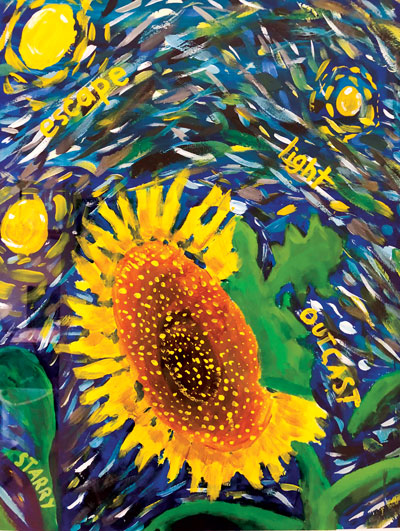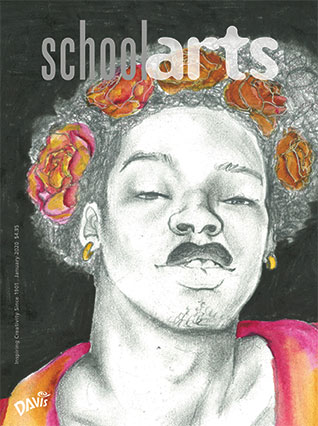 |
| Jack G., grade seven.; |
However, when students come to school struggling with issues related to mental health, we avoid them and are quick to place labels on their behavior.” To reach these goals within the context of an art lesson can admittedly be a bit lofty. However, I’ve found meaningful results through a unit inspired by Vincent van Gogh.
Van Gogh’s State of Mind
In a letter to his brother Theo in July of 1880, van Gogh compares a bird’s molting process to a person facing adversity. He proclaims that a person can stay in this state forever or come out a “new man”; either way, it is not something one wants to do in public. Vincent was aware of his mental state and yet, at times, felt trapped like a bird in a cage, knowing what it needed to survive but unable to be free. Vincent’s mind, his mental illness, was the cage.
I have chaperoned several trips with students to the Saint-Paul de Mausole, an asylum for the mentally ill in Saint-Rémy-de-Provence. It was here that van Gogh admitted himself in an attempt to regain his health. The grounds are peaceful and picturesque, and it is no wonder he was able to create arguably his best work during his yearlong stay. He was, after all, making art for himself for the sake of finding peace.
Identify and Empathize
There is more to take away from van Gogh’s life than just the headlines— that he painted sunflowers, that he painted a swirling nighttime scene called The Starry Night, that he mutilated his ear, and that he sold only one painting during his lifetime. The challenge is getting our students to move beyond the generalization that Vincent was an unwell artist who made some great paintings. Examining Vincent’s struggles with mental health can create opportunities to reach students in a meaningful and contemporary context. The practice of art-making can do this by itself; however, teaching about an artist who had the ability to convey his passion through writing and art allows students to identify and empathize.
Compassion and Empathy
I begin by asking students to develop a written composition about mental health. It can be in the form of a poem or short story, but should embody a sense of compassion. I suggest that students might write about personal experiences—a time when they felt disconnected, for example—using van Gogh’s life as a reference or sunflowers as a metaphor.
We then spend studio time drawing and painting sunflowers from a still-life setup and photos. I have found that drawing and painting sunflowers works best with this grade level in terms of understanding color theory, especially greens and yellows. Students often move away from the literal interpretation of their sunflower paintings to incorporate visual elements of what they wrote for their mental health composition. For example, one student wrote about the need to recharge his mind, and in turn, incorporated USB cords into the stem of his sunflower painting, reaching out to the sun for energy.
Incorporating Text
When the paintings were finished, students revisited their writing compositions to highlight important words or phrases that could be incorporated into their paintings using permanent and paint markers. Some students are hesitant to incorporate text into their paintings, but without fail, it enhances the work in a meaningful fashion, particularly for students who self-identify as having weaker drawing skills.
This unit provided students opportunities to practice exercises in mindfulness and to address mental health issues without judgment.
David Anderson is an art teacher at the Gilman School, a K–12 private school in Baltimore, Maryland. danderson@gilman.edu
NATIONAL STANDARD
Creating: Generate and develop artistic ideas and work.
WEB LINK
V incent van Gogh on Doctor Who: bit.ly/2m4wP3s
View this article in the digital edition.



